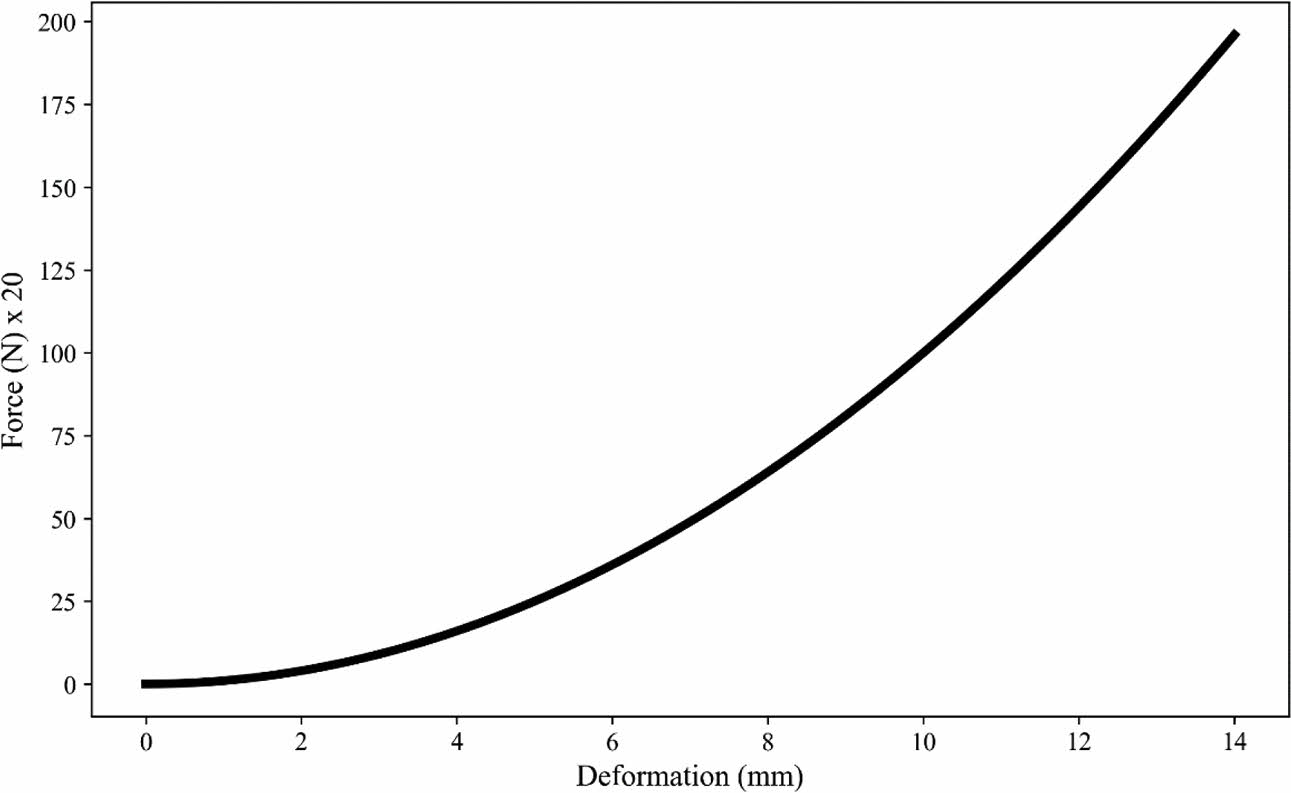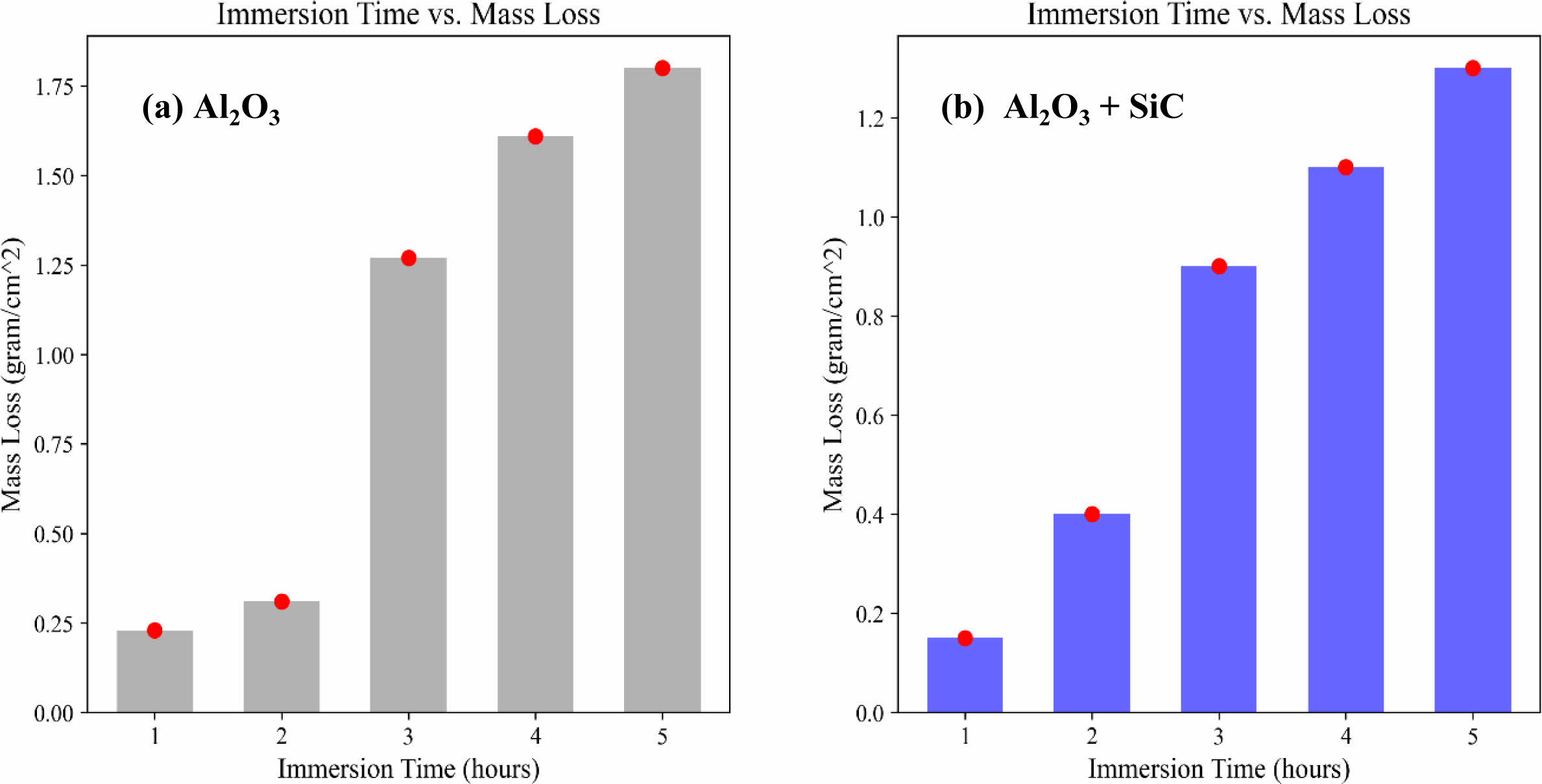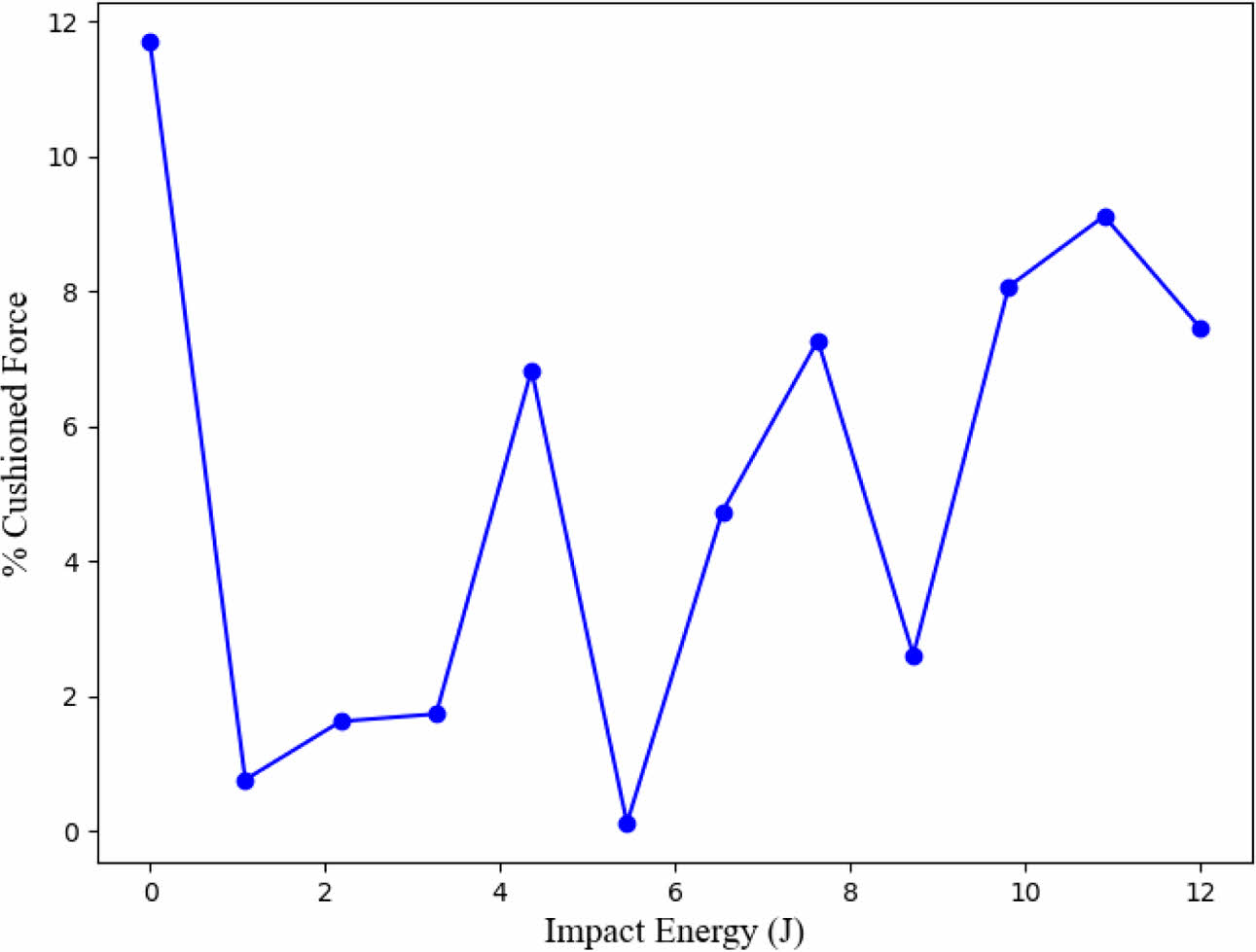- Study on the durability and wear resistance of Al2O3-SiC composite gripping element in sport shoes
Guo Loua and Changxi Fub,*
aDepartment of Physical Education, Jiangsu Vocational Institute of Commerce, Nanjing, Jiangsu, 211168, China
bDepartment of Physical Education, Xuzhou Institute of Technology, Jiangsu Xuzhou, 221008, ChinaThis article is an open access article distributed under the terms of the Creative Commons Attribution Non-Commercial License (http://creativecommons.org/licenses/by-nc/4.0) which permits unrestricted non-commercial use, distribution, and reproduction in any medium, provided the original work is properly cited.
This study investigates the durability and wear resistance of gripping element assemblies through mechanical loading and wear testing. The gripping element assembly underwent 5,000 cycles of loading and unloading, with each cycle applying a maximum load of 1800 N for 1 minute. Continuous monitoring of load, displacement, and time revealed excellent durability, with no visible signs of deformation or damage observed. Additionally, the assembly underwent wear testing, enduring 5,000 cycles of repeated contact with an abrasive surface under a constant load of 200. Minimal mass loss was measured after every 1,000 cycles, indicating outstanding resistance to abrasion and wear. The structural integrity and tread surface profile remained intact throughout the testing process, demonstrating the assembly’s ability to withstand prolonged usage without significant wear or deterioration. Furthermore, the study examines the relationship between mass loss and immersion time, revealing insights into composite material degradation in corrosive environments. The inclusion of SiC particles in the matrix results in reduced weight loss post-corrosion, highlighting the reinforcing effect of clumped SiC particles on the matrix-reinforcement bond. The observed complexities underscore the need for further investigation into particle-matrix interactions to optimize composite materials for enhanced performance and durability in corrosive conditions.
Keywords: Gripping element, SiC.
The integration of ceramic inserts into the gripping elements of sports shoes has long been proposed as a means to enhance durability and safety by leveraging the exceptional wear resistance of ceramics. Various ceramic materials, such as aluminum oxide, silicon carbide, and tungsten carbide, have been considered for this purpose, with the goal of preventing the formation of sharp edges and nicks on the gripping elements that pose injury risks. Despite these proposals, practical implementation has remained elusive due to challenges in achieving a secure and cost-effective connection between the ceramic insert and the gripping element body. Previous attempts have involved methods such as direct injection or adhesive bonding of the ceramic insert into a plastic gripping element body, yet these approaches have proven insufficient in withstanding the shear forces encountered during use, leading to detachment and loss of the ceramic inserts over time. In contrast, an alternative gripping element design has been proposed, featuring a ceramic gripping element body without the need for separate ceramic inserts. This design incorporates a flange-like widening at the upper end of the ceramic body, along with continuous recesses or cutouts, and is embedded within a substructure composed of glass or carbon fiber reinforced polyamide. The plastic material of the substructure is intended to penetrate or interlock with the recesses and cutouts, thereby securely fixing the ceramic gripping element body in place.
Recent research studies have delved into addressing the challenges associated with integrating ceramic inserts into the gripping elements of sports shoes, aiming to improve durability and safety while maintaining cost-effectiveness. A literature survey reveals several notable studies that have contributed insights and advancements in this field. Magnesium matrix composites, reinforced with TiC, were effectively produced through the spontaneous infiltration of molten magnesium alloy into Al-Ti-C preforms, leading to the in situ formation of TiC particles within the magnesium alloy liquid. The damping properties of these magnesium matrix composites, reinforced with in situ TiC, were examined. Findings from experiments indicate that the damping capacity of the magnesium alloy rises proportionally with the reinforcement percentage. The enhanced damping capabilities of the composites can be ascribed to the dislocation damping mechanism at room temperature. Furthermore, at elevated temperatures, interface damping emerges as a novel contributor to the augmentation of damping capacity [1].
Aydin et al. in a previous study explored the mechanical, wear, and corrosion properties of TiC reinforced AZ91 matrix composites. AZ91 alloy and AZ91/TiC composites with varying weight fractions of 10, 20, and 30 (wt%) were manufactured using powder metallurgy combined with hot pressing techniques. Microstructural analysis revealed partial particle agglomeration, particularly notable in the AZ91/30 wt% TiC composite. The inclusion of TiC resulted in notable enhancements in hardness and wear resistance, with observed wear mechanisms being primarily abrasive in nature. Moreover, compared to AZ91, the compressive yield strength and ultimate compressive strength of the composites showed significant improvements. However, the corrosion rate increased with the incorporation of TiC particles due to the presence of galvanic reactions.
Recently, Ko et al., examined the immediate effects of CFI on athletic performance, lower limb muscle activity, and perceived comfort. Thirty young, healthy males with shoe sizes ranging from 260 to 270 mm engaged in various sports tasks (including power generation, agility, and speed) and treadmill runs while wearing wearable sensors, under two experimental insole conditions: a benchmark insole serving as the control, and CFI. The findings indicated that, compared to the benchmark insole, CFI resulted in significant enhancements in sports performance, specifically in power generation (by approximately 1.5%) and agility (by around 1%). However, it also elicited increased activation of the Tibialis Anterior (by approximately 0.7%) and Gastrocnemius Medialis (by roughly 0.8%) muscles, and was perceived as being stiffer and less comfortable. These outcomes suggest that while CFI may lead to improvements in athletic performance, it may also induce greater activation of lower limb muscles and subjective discomfort [3]. However, despite these advancements, significant challenges remain in developing a ceramic gripping element that effectively balances durability, performance, and cost considerations. Addressing these challenges requires innovative solutions that not only ensure the robust integration of ceramic components but also optimize manufacturing processes to maintain competitive pricing relative to conventionally designed gripping elements. This study aims to explore novel approaches to overcoming these obstacles and advancing the practical implementation of ceramic gripping elements in sports footwear, with a focus on enhancing both performance and user safety [4-8].
The gripping element body was fabricated using flowable plastic materials such as Polyamide or polyurethane, utilizing injection molding techniques. The ceramic insert was composed of materials such as aluminum oxide (Al2O3), silicon carbide (SiC), or steatite. It featured a lower lenticular part forming the tread surface and an upper substantially cylindrical part with three parallel circumferential ring ribs. The metal sleeve, made of steel, overlapped the upper part of the ceramic insert and formed a flat bottom to support the ceramic insert directly. It had four circular openings distributed uniformly over its circumference.
The gripping element assembly was meticulously constructed by integrating the ceramic insert into the metal sleeve, ensuring proper alignment and fitment. Mechanical tests were conducted to evaluate the assembly’s resistance to twisting and bending forces. A turning tool was engaged with the engagement surfaces of the gripping element, and torque was applied to assess its resistance to involuntary twisting. Durability tests were performed to assess the assembly’s ability to withstand prolonged usage and environmental conditions. The assembly was subjected to cyclic loading and unloading to simulate typical usage scenarios. Wear tests were conducted to evaluate the assembly’s resistance to abrasion and wear. The assembly was subjected to repeated contact with abrasive surfaces to simulate real-world wear conditions.
The gripping element assembly was mounted onto a mechanical testing apparatus capable of applying cyclic loading and unloading. The assembly underwent 5,000 cycles (5k) of loading and unloading (0-1800), with each cycle consisting of a maximum load of 1800 N applied for 1 minute followed by a period of unloading (Fig. 1). The applied load, displacement, and time were continuously monitored throughout the testing process. The gripping element assembly demonstrated excellent durability, with no visible signs of deformation or damage observed after completing the 5k cycles of loading and unloading. The assembly maintained its structural integrity and functionality throughout the test, indicating its ability to withstand prolonged usage without failure [9, 10].
The gripping element assembly was mounted onto a wear testing machine equipped with an abrasive surface. The assembly was subjected to 5k cycles of wear testing, with each cycle consisting of repeated contact with the abrasive surface under a constant load of 200. The mass loss of the gripping element assembly was measured after every 1k cycles of wear testing using a precision scale. The wear test results revealed minimal mass loss of the gripping element assembly, indicating excellent resistance to abrasion and wear. The assembly maintained its structural integrity and tread surface profile throughout the testing process, demonstrating its ability to withstand prolonged usage without significant wear or deterioration.
The observed relationship between mass loss and immersion time, as depicted in Fig. 2, highlights significant trends associated with the inclusion of SiC and the duration of immersion. It becomes evident that as immersion time increases, the mass loss also notably rises. Specifically, after 2 hours of immersion, the mass loss of the original sample surpasses that of the SiC composite sample by approximately two-fold. This observation suggests a compelling phenomenon wherein the clumping together of SiC particles may reinforce the bond between the matrix and reinforcement [11-14]. As a result, the detachment of SiC particles from the specimen’s corrosion surface becomes more challenging, leading to reduced weight loss post-corrosion and ultimately accelerating the overall corrosion rate. This finding underscores the intricate interplay between composite composition, immersion time, and corrosion behavior, providing valuable insights into the mechanisms underlying material degradation in corrosive environments. Further investigation into the specific mechanisms governing particle-matrix interactions and their impact on corrosion resistance is warranted to fully elucidate these observations and optimize composite materials for enhanced performance and durability in corrosive conditions.
The plotted curve (Fig. 3) represents the relationship between impact energy and % cushioned force. Impact energy refers to the amount of energy transferred during an impact, while % cushioned force represents the percentage of force absorbed or cushioned by a material or structure upon impact. The curve shows that as impact energy increases, the % cushioned force tends to vary unpredictably. This variability can be attributed to several factors, including the properties of the cushioning material, the design of the structure, and the dynamics of the impact event [17, 18]. The observed randomness in the data highlights the complex nature of impact absorption and cushioning. Different materials and structures may exhibit varying degrees of cushioning performance under similar impact conditions due to factors such as elasticity, damping properties, and deformation characteristics. Moreover, the absence of a clear trend in the data suggests that % cushioned force may not be solely dependent on impact energy but may also be influenced by other factors such as the duration of the impact, the angle of impact, and the mechanical properties of the impacting object and the cushioning material. Further analysis and experimentation are needed to fully understand the underlying mechanisms governing the relationship between impact energy and % cushioned force. This could involve studying the microstructure of the cushioning material, conducting impact tests under controlled conditions, and exploring alternative cushioning materials and designs [15, 16].

|
Fig. 1 Force-Displacement curve |

|
Fig. 2 depicts the relationship between mass loss and immersion time of the samples. |

|
Fig. 3 Impact energy (J) and % cushioned force. |
The gripping element assembly underwent rigorous testing to assess its durability and resistance to wear. The assembly demonstrated exceptional performance, withstanding 5,000 cycles of loading and unloading without any visible signs of deformation or damage. This indicates its ability to maintain structural integrity and functionality even under prolonged usage conditions. Additionally, the assembly exhibited minimal mass loss during wear testing, highlighting its remarkable resistance to abrasion and wear. The observed relationship between mass loss and immersion time in SiC composite samples further emphasized the intricate interplay between composite composition, immersion time, and corrosion behavior. These findings provide valuable insights into the mechanisms underlying material degradation in corrosive environments and underscore the need for further research to optimize composite materials for enhanced performance and durability. Overall, the gripping element assembly shows great promise for practical applications in demanding environments where durability and resistance to wear are essential considerations. Further studies are warranted to explore and refine the mechanisms underlying its exceptional performance and to facilitate its widespread use in various industrial settings.
- 1. W. Cao, C. Zhang, T. Fan, and D. Zhang, Mater. Sci. Eng. A 496 (2008) 242-246.
-

- 2. F. Aydin, Y. Sun, and M.E. Turan 54[2] (2020) 141-152.
-

- 3. M. Ko, T. Ma, and S. Xiong, Sensors 23[4] (2023) 2154.
-

- 4. D.M. Lee, B.K. Suh, and B.G Kim, Mater. Sci. Technol. 13 (1997) 590-595.
-

- 5. J. Hu, X. Tian, C. Hu, Y. Luo, H. Peng, and J. Luo, J. Ceram. Process. Res. 17[11] (2016) 1181-1187.
-

- 6. Y.-W. Kim, Y.J. Jin, Y.S. Chun, I.H. Song, and H.D. Kim, Scr. Mater. 53[8] (2005) 921-925.
-

- 7. Z. Zhang and D.L. Chen, Scr. Mater. 54 (2006) 1321-1326.
-

- 8. J.W. Luster, M. Thumann, and R. Baumann, Mater. Sci. Technol. 9 (1993) 853-862.
-

- 9. J.F. Archard, J. Appl. Phys. 24 (1953) 981-988.
-

- 10. A. Pardo, S. Merino, M.C. Merino, I. Barroso, M. Mohedano, R. Arrabal, and F. Viejo, Corros. Sci. 51 (2009) 841-849.
-

- 11. E. Ghali, W. Dietzel, and K.U. Kainer, J. Mater. Eng. Perform. 13 (2004) 7-23.
-

- 12. K.N. Fatema, H.M. Lim, J.S. Hong, K.S. Lee, and I.J. Kim, J. Ceram. Process. Res. 24[1] (2023) 197-204.
-

- 13. L. Pupure, J. Varna, R. Joffe, F. Berthold, and A. Miettinen, Wood Mater. Sci. Eng. 15[2] (2020) 76-86.
-

- 14. J. Hu, Q. Huang, H. Peng, X. Tian, Z. Chen, and Y. Peng, J. Ceram. Process. Res. 19[3] (2018) 224-230.
-

- 15. B. Basnet, H.M. Lim, K.S. Lee, and I.J. Kim, J. Korean Ceram. Soc. 56[5] (2019) 513-520.
-

- 16. H. Qiu, H. Sun, X. Liu, H. Sui, and D. Huang, J. Mater. Sci.: Mater. Electron. 33[15] (2022) 12171-12181.
-

- 17. A. Alraisi, Y. Yi, S. Lee, S.A. Alameri, M. Qasem, C.Y. Paik, and C. Jang, Ann. Nucl. Energy 165 (2022) 108784.
-

- 18. M. Alrwashdeh and S.A. Alameri, Energies 15[21] (2022) 8008.
-

 This Article
This Article
-
2024; 25(3): 421-424
Published on Jun 30, 2024
- 10.36410/jcpr.2024.25.3.421
- Received on Mar 22, 2024
- Revised on Apr 2, 2024
- Accepted on Apr 4, 2024
 Services
Services
Shared
 Correspondence to
Correspondence to
- Changxi Fu
-
Department of Physical Education, Xuzhou Institute of Technology, Jiangsu Xuzhou, 221008, China
Tel : +8613813933901 Fax: +86 025 52710922 E-mail: loug2024@163.com - E-mail: loug2024@163.com






 Copyright 2019 International Orgranization for Ceramic Processing. All rights reserved.
Copyright 2019 International Orgranization for Ceramic Processing. All rights reserved.